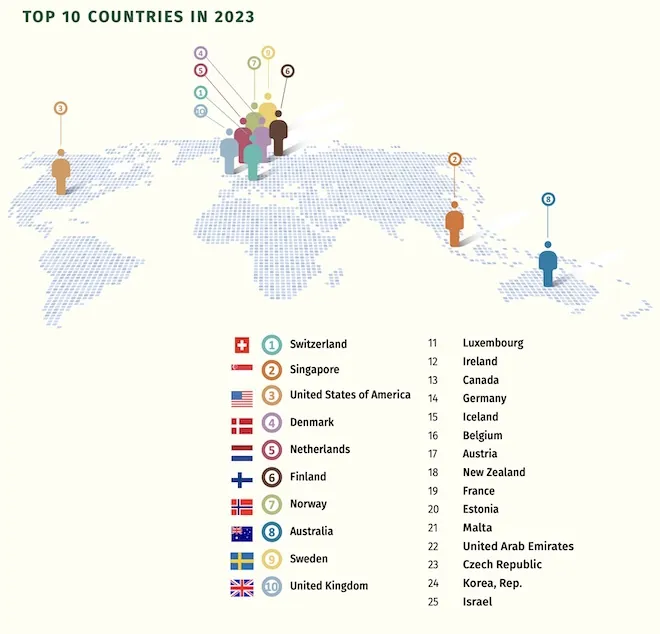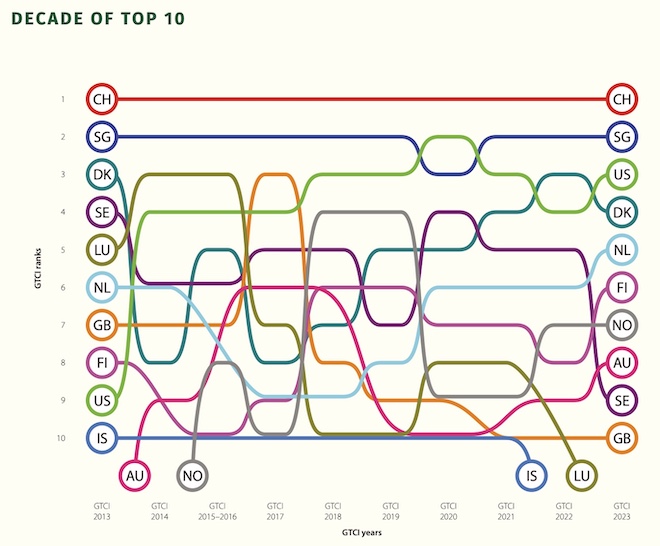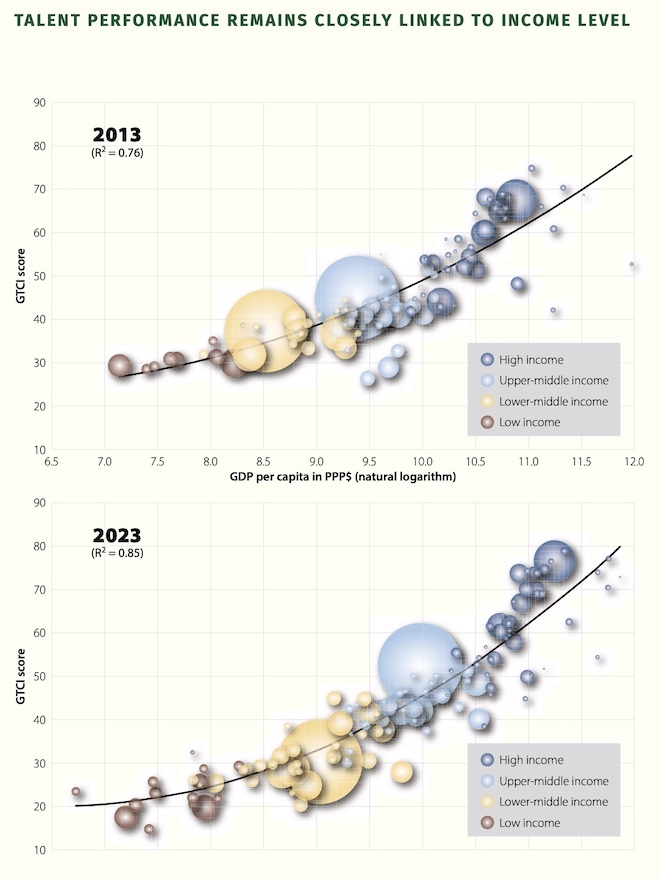
Talent goes where it’s most prized and rewarded, and year after year, the same group of countries steadfastly attract and keep the world’s most talented workers. But changes are brewing, with emerging economies slowly but steadily improving their talent competitiveness.
Those are the chief conclusions in the Global Talent Competitiveness Index published annually by leading French business school INSEAD. This year’s index names Switzerland, Singapore, and the United States as the world’s top three most talent-competitive countries, positions they have firmly maintained for years. Denmark, the Netherlands, Finland, Norway, Australia, Sweden, and the United Kingdom make up the rest of the top 10 in 2023. Across the top 25, European countries continue to dominate, with 17 of them ranked; beyond Europe, joining the top 25 this year are Australia, Canada, New Zealand, the United Arab Emirates, South Korea, and Israel. UAE has moved up from 25th to 22nd, while Japan dropped out, replaced by South Korea at 24th.
Significantly as the GTCI marks one decade of existence: From 2013 to 2023, the top 10 countries have largely remained the same, with eight of the top 10 this year also in the inaugural top 10 a decade ago.
‘TALENT COMPETITION WILL BE ONE OF THE PILLARS OF THE NEXT AGE OF GLOBALIZATION’
Now in its 10th year, the GTCI measures how countries and cities grow, attract, and retain talent, and aims to provide a resource for decision makers in understanding the global talent landscape so they can better develop economic strategies.
The 2023 GTCI report, titled “What a difference ten years make — and what to expect for the next decade,” was released November 6. It is published by INSEAD in collaboration with the Descartes Institute for the Future, an independent, non-profit consultancy in multilateral projects based in Geneva, Switzerland; and with the Human Capital Leadership Institute, which facilitates leadership development and strategic human capital management capabilities in Asia. The 2023 report covers 134 countries around the world across all income groups.
“For the past 10 years, GTCI has been at the forefront of benchmarking and analytical thinking in the areas of labor markets, work organization, and talent flows,” says Bruno Lanvin, co-author of the report (with INSEAD professor of strategy Felipe Monteiro) and a distinguished fellow at INSEAD. Lanvin is also the founder and president of the Descartes Institute.
“It is now time to look at the future. Talent competition will be one of the pillars of the next age of globalization. Our collective ability to make the world less unequal, and the planet more sustainable, will depend heavily on our capacity to grow, attract, and nurture the right talents.”

Source: GTCI
6 MAJOR TRENDS EMERGE OVER THE LAST 10 YEARS
Since the founding of the GTCI in 2013, Lanvin and Monteiro write, six major trends have emerged:
- Between countries, talent inequalities remain high: “One of the most recurrent themes has been that the global talent competitiveness landscape is fraught with inequalities. Poorer economies do not perform as well on the talent scene as richer economies have. Despite significant progress made by some of the largest emerging economies such as India and China, the wealth/talent correlation remains strong.”
- Within societies, talent inequalities are hard to fix: “Despite progress in reducing gender gaps, women continue to face unequal pay and limited career growth. While Covid-19 thwarted the process, pushing some to irreversible levels, the post-Covid recovery may deepen them further. AI and new work practices are changing the job landscape, affecting both unskilled and highly skilled workers.”
- The coronavirus pandemic has permanently changed the global talent landscape: “During the Covid years, national and organizational talent strategies have been challenged to adapt to a dramatically changed environment for education, work, and activity. The new practices adopted will contribute to a new normal and a new world of work is emerging and evolving. For talent, ‘quality of life’ is increasingly important, and this trend might possibly accelerate in subsequent years.”
- Cities and regions play increasingly important roles in talent: “Global City Talent Competitiveness Index (GCTCI) repeatedly emphasized how cities had been able to deploy original and effective talent strategies, and how ‘second-tier’ cities were increasingly successful at deploying talent policies.”
- Growing and persistent uncertainties are stifling talent development: “The recent period (as well as the one that is lying ahead) has not offered fertile ground for one of the most positive trends identified by GTCI before Covid, namely ‘brain circulation.’ Although international travel has resumed, persistent uncertainties and geopolitical tensions continue to hinder direct (face-to-face) cooperation and limit talent cross-fertilization.”
- Younger workers are making their mark: “An increasing proportion of new generations, especially the higher educated, didn’t necessarily prioritize high-demand skills. Many look for meaningful jobs where they can contribute to society or desire a healthier work-life balance. Gigs and short-term contracts have also become the new norm for a growing number of workers.”

Source: GTCI
‘A VERY RICH PICTURE’
In the 10th year of the index, Lanvin says in a video accompanying the report (see above), “We now have a very rich picture of how nations and cities have competed to attract and nurture talent over the past decade. In the 2023 rankings, Switzerland maintains its lead as the most talent-competitive country, with Singapore and the United States closely following. These top three countries have been consistent over the past decade. Denmark, the Netherlands, Finland, Norway, Australia, Sweden and the United Kingdom make up the rest of the Top 10.
“In the top 25, European nations hold a significant presence, with 17 of them making the cut. The most notable change in the top 25 this year is that for the first time it no longer includes Japan, which was replaced by South Korea.
“One of the major trends that we have seen over the past decade is that talent inequalities remain high among countries. Year after year we have seen an unwavering link between a country’s wealth and its talent competitiveness. Richer countries continue outshine poorer economies on the global talent stage. Even when inequalities show signs of receding, they remain substantial.”
Lanvin’s co-author, INSEAD professor Felipe Monteiro, says changes are brewing among the world’s emerging economies.
“Over the past decade, the top 10 most talent-competitive countries have remained steady. Remarkably, eight of the top 10 countries this year were also in the inaugural top 10 in 2013,” says Monteiro, who is also program director for INSEAD’s partner program with Fundação Dom Cabral, Advanced Management Program.
“While we have seen stability at the top, and persistent inequalities in the global talent landscape, changes are brewing beneath the surface. And where do those changes come from? It’s basically from emerging markets.
“If we take the combined GDP of the E7, which is the seven top emerging economies, they are comparable to the G7. Actually, if we take them in PPP terms, they could be even higher. So how does that translate into talent competitiveness? China’s rise in the rankings, moving from 47th to 40th place, highlights the potential for emerging economies to challenge the existing global talent hierarchy.
“A closer look at the decade-long GTCI time series reveals that several of the largest emerging economies are progressing. China has improved its GTCI score and become a talent champion, and Indonesia and Mexico have taken great strides in talent competitiveness. While Brazil is still among the talent laggards, it has progressed within that quadrant, and may well soon classify as a talent mover. All four countries have improved in their ability to retain talent.
“Since 2020, the share of countries from Latin America and Western Asia and the Middle East that are talent champions has also increased.”

Source: GTCI
6 KEY MESSAGES FOR THE FUTURE
The GTCI includes a “time capsule” of six key messages in envisioning what the global talent landscape will look like in 2033:
- Talent competitiveness will gain even more importance as a critical element of competitiveness, innovation and geo-political soft power for nations, cities and organizations.
- Talent competition will grow fiercer. As uncertainties and international tensions will continue to accumulate (in trade, in investment, in politics and diplomacy), there will be growing talent wars.
- The world of work will further transform, driven by evolving expectations from younger generations, new economic models and emerging technologies like AI.
- Cities and regions will pioneer new talent strategies and innovation. Quality of life and sustainability will be a critical asset for those aiming at becoming talent hubs.
- Global talent-focused policies will be crucial to prevent tensions and harness human and technological potential for a better, more sustainable and equal world.
- Skills and education will remain vital tools to empower workers to make meaningful contributions to their economies and societies.
“The GTCI Index highlights and focuses on factors that support human capital. Improvements in each lever of the index, not just in the overall rankings, should be celebrated,” says Doris Sohmen-Pao, CEO of the Human Capital Leadership Institute. “While there has been minimal movement in the rankings over the past 10 years, there have been rapid changes in talent management across industries. This is especially so within companies as they respond to technological transformations, the pandemic, as well as the drive for sustainability.
“We imagine the next decade will see more visible changes in the rankings—with countries in Asia advancing in competitiveness mirroring growth across the industry. This increase in the ability to attract, retain, and grow human capital should be seen as a win for all.”
See the full GTCI report here.
DON’T MISS INSEAD REVAMPS ITS MBA CURRICULUM, PUTTING A HEAVY FOCUS ON SUSTAINABILITY





Questions about this article? Email us or leave a comment below.